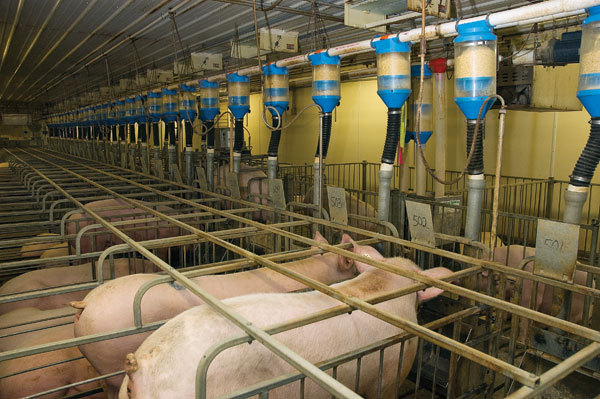McDonald’s Gestation Stall Policy Means Higher Costs
The tradeoffs to the loss of gestation stalls are more sow injuries, higher feed and labor costs, and very likely more injuries to workers.
February 15, 2012

Monday��’s announcement by McDonald’s Corporation that it would ask its suppliers to outline their plans for phasing out the use of sow gestation stalls was all the buzz in the agricultural media this week. The move by the nation’s largest quick-serve restaurant operator is certainly the most dramatic move against a pork industry production practice – and perhaps any on-farm livestock production practice – to date. But many questions remain regarding the decision’s impact.
Gestation stalls are individual enclosures usually measuring 2 ft. by 7 ft., in which sows are housed during the breeding and gestation (pregnancy) phases of their reproductive cycles. The stalls allow a limited amount of mobility from front to back but do not allow the animal to turn around or to have direct contact with animals except the ones to either side. Automated feed systems drop specified amounts of feed to the animals at prescribed times. Each stall has access to fresh water from either a trough at the front or a nipple-type waterer, which the animal bites to release water into its mouth. Sows spend 15 of a roughly 18-week reproductive cycle in gestation stalls.
The other three weeks of the reproductive cycle are spent in a farrowing stall, an individual enclosure about the same size as the gestation stall but designed to allow piglets to move under the stall’s sides to get away from the sow when she lays down, preventing crushing. Each farrowing stall has an area for piglets that is about 1 ft. by 7 ft. on each side of the sow. The area has supplemental heat to keep pigs warm since newborn pigs cannot regulate their body temperatures well at all.
The McDonald’s announcement deals only with gestation stalls. There is little opposition to farrowing stalls of which we are aware. While confining a sow for three weeks may not be ideal in some people’s minds, the welfare of a 3-lb. baby pig that is suffocated by a 500-lb. sow isn’t particularly high, making this piece of equipment far more acceptable, we think, even to animal welfarists.
The use of gestation stalls began in earnest in the 1980s. They were one of three sow confinement practices that really began in Europe and then spread to the U.S. The first two – girth tethers and neck tethers – were less expensive than stalls but were almost completely abandoned in the U.S. in the ’90s due to both practicality (sows sometimes slipped out of their tether harnesses, some harnesses caused skin lesions, etc.) and welfare concerns.
Gestation stall benefits
The two primary benefits of gestation stalls are:
• They remove the social stress of group-housed sows. Pigs are social animals and will always establish a hierarchy or pecking order. That process is not pretty in group-housed sows as there is often serious fighting when groups are formed and intermittent fighting at all times as the “order” is enforced. That fighting and stress leads to injuries such as cuts, scratches, torn ears and, in some cases, broken bones. These are prevented by stalls.
• They allow sows to be managed as individuals. Thin sows can be given more feed, without that extra feed being stolen by a larger boss sow. Meanwhile, heavy sows can be fed less to maintain body condition more conducive to productivity and longevity. Health challenges are easier to observe and treat.
It’s no coincidence that the productivity in litters/sow increased significantly as more and more U.S. sows were moved to stalls beginning in the 1990s. Of course, stalls were not the only factor in this improvement, as artificial insemination, more accurate pregnancy detection and other practices all played a role. But indoor-housed, stalled sows were a major driver.
All systems have trade-offs. The obvious negative one for sow stalls is that sows are denied many of their natural behaviors. As noted above, some of those behaviors can be destructive. But they are natural and that seems to be the primary concern of groups like the Humane Society of the U.S. It now seems to be the primary concern of McDonald’s as well.
Can pork producers meet these demands? Yes. Will there be a cost? Yes. There are two viable alternatives to stalls: small groups of, generally, 6-12 sows and large groups of as many as 100 sows. Both allow sows slightly more individual space and the freedom to turn around and interact with other animals.
Small-group systems usually use a feed-delivery system that meters feed to individual feeding stations at a rate the sow can eat immediately, thus providing no loss to a weaker, more timid sow and no gain to a boss sow.
Large-group systems usually use electronic feeding stations, which read ear tags and allow sows only so much feed during a specific time period, thus regulating body condition. Productivity levels close to those of stall systems can be achieved.
The tradeoffs are more sow injuries, higher feed costs (mobility takes energy), higher labor costs, and very likely more injuries to workers. Those will not be free and, in the long run, consumers pay all costs. That last one always seems hard to remember.
You May Also Like



